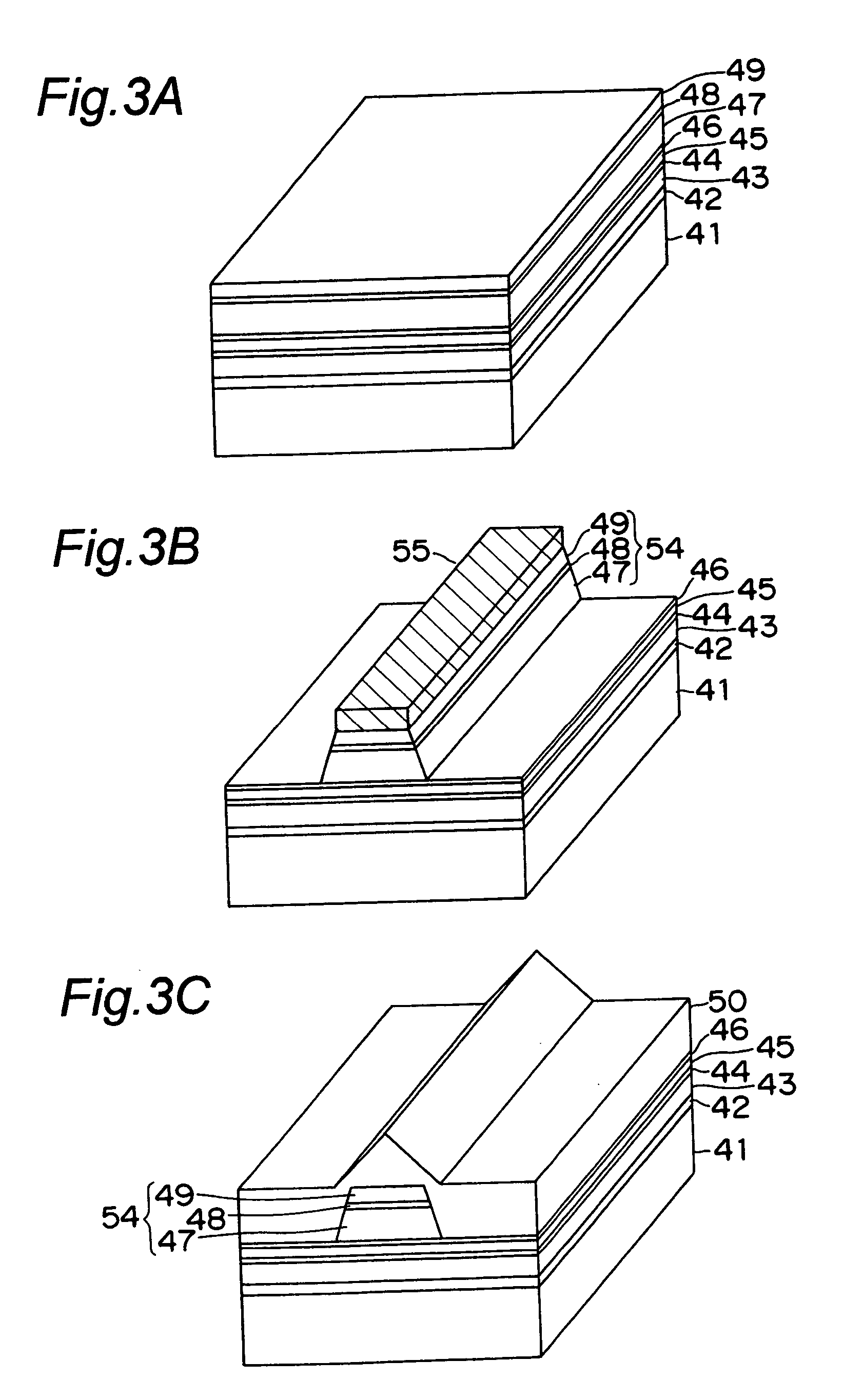Semiconductor laser device and method of producing the same
a laser device and semiconductor technology, applied in semiconductor lasers, laser optical resonator construction, laser details, etc., can solve the problems of insufficient capacity of conventional semiconductor laser devices, catastrophic optical damage (cod), and achieve superior long-term reliability and reduce driving current
- Summary
- Abstract
- Description
- Claims
- Application Information
AI Technical Summary
Benefits of technology
Problems solved by technology
Method used
Image
Examples
first embodiment
[0081]FIG. 1 is a perspective view of a semiconductor laser device according to a first embodiment of the present invention, showing a light emission end face of the device. FIG. 2A is a cross-sectional view taken along line 2A-2A of FIG. 1, showing parts including a waveguide. And, FIG. 2B is a cross-sectional view taken along line 2B-2B of FIG. 1.
[0082] In FIG. 1, reference numeral 41 denotes an n-type GaAs substrate (carrier concentration: 2×1018 cm−3), reference numeral 42 denotes an n-type GayInzP (0≦y, z≦1) buffer layer (carrier concentration: 1×1018 cm−3, y=0.515, z=0.485, film thickness: about 0.2 μm), and reference numeral 43 denotes an n-type AlxGayInzP (0≦x≦1) first cladding layer (carrier concentration: 1×1018 cm−3, x=0.360, y=0.155, z=0.485, film thickness: about 2 μm) . Reference numeral 44 denotes an active layer (MQW active layer) constructed of a multiquantum well structure of alternating AlxGayInzP barrier layers (x=0.258, y=0.257, z=0.485; each having a film thic...
second embodiment
[0104]FIG. 5 is a perspective view of a semiconductor laser device according to a second embodiment of the present invention, showing a light emission end face of the device. FIG. 6A is a cross-sectional view taken along line 6A-6A of FIG. 5, showing parts including a waveguide. And, FIG. 6B is a cross-sectional view taken along line 6B-6B of FIG. 5.
[0105] In FIG. 5, reference numeral 61 denotes an n-type GaAs substrate (carrier concentration: 2×1018 cm−3), reference numeral 62 denotes an n-type GayInzP (0≦y, z≦1) buffer layer (carrier concentration: 1×1018 cm−3, y=0.515, z=0.485, film thickness: about 0.2 μm), and reference numeral 63 denotes an n-type AlxGayInzP (0≦x≦1) first cladding layer (carrier concentration: 1×1018 cm−3, x=0.360, y=0.155, z=0.485, film thickness: about 2 μm). Reference numeral 64 denotes an active layer (MQW active layer) constructed of a multiquantum well structure of alternating AlxGayInzP barrier layers (x=0.258, y=0.257, z=0.485; each having a film thic...
third embodiment
[0136]FIG. 9 is a perspective view of a semiconductor laser device according to a second embodiment of the present invention, showing a light emission end face of the device. FIG. 10A is a cross-sectional view taken along line 10A-10A of FIG. 9, showing parts including a waveguide. And, FIG. 10B is a cross-sectional view taken along line 10B-10B of FIG. 9.
[0137] In FIG. 9, reference numeral 81 denotes an n-type GaAs substrate (carrier concentration: 2×1018 cm−3), reference numeral 82 denotes an n-type GayInzP (0≦y, z≦1) buffer layer (carrier concentration: 1×1018 cm−3, y=0.515, z=0.485, film thickness: about 0.2 μm), and reference numeral 83 denotes an n-type AlxGayInzP (0≦x≦1) first cladding layer (carrier concentration: 1×1018 cm−3, x=0.360, y=0.155, z=0.485, film thickness: about 2 μm). Reference numeral 84 denotes an active layer (MQW active layer) constructed of a multiquantum well structure of alternating AlxGayInzP barrier layers (x=0.258, y=0.257, z=0.485; each having a fil...
PUM
 Login to View More
Login to View More Abstract
Description
Claims
Application Information
 Login to View More
Login to View More - R&D
- Intellectual Property
- Life Sciences
- Materials
- Tech Scout
- Unparalleled Data Quality
- Higher Quality Content
- 60% Fewer Hallucinations
Browse by: Latest US Patents, China's latest patents, Technical Efficacy Thesaurus, Application Domain, Technology Topic, Popular Technical Reports.
© 2025 PatSnap. All rights reserved.Legal|Privacy policy|Modern Slavery Act Transparency Statement|Sitemap|About US| Contact US: help@patsnap.com



